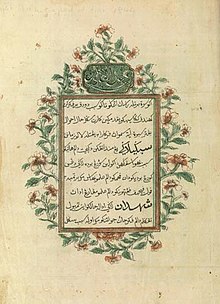Statistical Genetics Wiki
Spis treści

Pismo jawi (جاوي), yawi – wariant pisma arabskiego używany historycznie do zapisu języka malajskiego i innych języków w regionie Azji Południowo-Wschodniej[1]. Służył do zapisywania takich języków jak: aceh, minangkabau, bandżar[2], ternate[2][3], tausug[4] i maguindanao[5].
Ukształtowało się wraz z nadejściem islamu (XIV–XV w.)[6]. Pismo jawi zostało w dużej mierze wyparte przez alfabet łaciński, zyskujący na znaczeniu od XVII wieku. W pewnym zakresie zachowało się w sułtanacie Brunei i w Malezji, lecz nie ma charakteru prymarnego[1]. Bywa wykorzystywane w niektórych publikacjach[6]. W Brunei pismo jawi uchodzi za element tożsamości narodowej i jego użycie obowiązuje w przestrzeni publicznej (na znakach drogowych, billboardach i szyldach)[7]. Dodatkowo ma stosunkowo silną pozycję wśród ludności malajskiej w południowej Tajlandii[8].
Najwcześniejszym przykładem użycia pisma jawi jest XIV-wieczna inskrypcja z Terengganu. Najstarsze dokumenty w piśmie jawi to dwa listy sułtana Ternate, zaadresowane do króla Portugalii (1520–1521)[1][9].
Obecnie jest jednych z dwóch oficjalnych systemów pisma w Brunei i Malezji. Pozostaje również w użyciu w regionie Pattani w Tajlandii (do zapisu malajskiego pattani, obok pisma tajskiego)[10] oraz w stanie Kelantan w Malezji.
Przypisy
- ↑ a b c Tadmor 2005 ↓, s. 646.
- ↑ a b Oman Fathurahman, Filologi Indonesia: Teori dan Metode, Jakarta: Prenada Media, 2015, s. 128, ISBN 978-623-218-153-3, OCLC 1001307264 [dostęp 2022-09-07] (indonez.).
- ↑ Voorhoeve 1994 ↓, przyp. 10, s. 659.
- ↑ Adelaar i in. 1996 ↓, s. 688.
- ↑ Annabel Teh Gallop. Two letters in Maguindanao. „Asian and African studies blog”, 2014-06-26. The British Library Board. [dostęp 2022-09-10]. [zarchiwizowane z adresu 2022-09-10]. (ang.).
- ↑ a b George Quinn, The Learner’s Dictionary of Today’s Indonesian, Sydney: Allen & Unwin, 2001, s. xii, DOI: 10.4324/9781003118046, ISBN 978-1-86448-543-1, ISBN 978-1-003-11804-6, ISBN 978-1-000-25184-5, OCLC 46455219 (ang.).
- ↑ Saxena 2016 ↓, s. 53, 56.
- ↑ Tadmor 2009 ↓, s. 795.
- ↑ Tadmor 2009 ↓, s. 794.
- ↑ Hoogervorst 2024 ↓, s. 234.
Bibliografia
- H.S. Paterson (& C.O. Blagden). An early Malay Inscription from 14th-century Terengganu. „Journ. Mal. Br.R.A.S.”. II, s. 258–263, 1924. (ang.).
- R.O. Winstedt: A History of Malaya. Wyd. popr. 1962, s. 40. (ang.).
- J.G. de Casparis: Indonesian Paleography. 1975, s. 70–71. (ang.).
- K. Alexander Adelaar, David J. Prentice, Cornells D. Grijns, Hein Steinhauer, Aone van Engelenhoven: Malay: its history, role and spread. W: Stephen A. Wurm, Peter Mühlhäusler, Darrell T. Tryon (red.): Atlas of Languages of Intercultural Communication in the Pacific, Asia, and the Americas: Vol I: Maps. Vol II: Texts. Berlin–New York: Walter de Gruyter, 1996, s. 673–693, seria: Trends in Linguistics. Documentation 13. DOI: 10.1515/9783110819724.2.673. ISBN 978-3-11-081972-4. OCLC 1013949454. (ang.).
- Tom Hoogervorst: Language policy and the politics of language. W: K. Alexander Adelaar, Antoinette Schapper (red.): The Oxford Guide to the Malayo-Polynesian Languages of Southeast Asia. Oxford: Oxford University Press, 2024, s. 225–235. DOI: 10.1093/oso/9780198807353.003.0017. ISBN 978-0-19-253426-2. ISBN 978-0-19-880735-3. OCLC 1449546728. (ang.).
- Mukul Saxena: Lifestyle Diglossia and Mobile: Ethnography of Multilingual Interaction. W: Xu Xiaoge (red.): Handbook of Research on Human Social Interaction in the Age of Mobile Devices. Hershey: IGI Global, 2016, s. 49–60, seria: Advances in Human and Social Aspects of Technology. DOI: 10.4018/978-1-5225-0469-6.ch003. ISBN 978-1-5225-0469-6. ISBN 978-1-5225-0470-2. OCLC 952185211. (ang.).
- Uri Tadmor: Malay-Indonesian and Malayic languages. W: Philipp Strazny (red.): Encyclopedia of Linguistics. T. 2: M–Z. New York: Fitzroy Dearborn, 2005, s. 644–647. DOI: 10.4324/9780203319208. ISBN 978-1-57958-451-1. OCLC 55679645. (ang.).
- Uri Tadmor: Malay-Indonesian. W: Bernard Comrie (red.): The World’s Major Languages. Wyd. 2. Abingdon–New York: Routledge, 2009, s. 791–818. DOI: 10.4324/9780203301524. ISBN 978-1-134-26156-7. OCLC 282550660. (ang.).
- Clemens L. Voorhoeve: Contact-induced change in the non-Austronesian languages in the north Moluccas, Indonesia. W: Tom Dutton, Darrell T. Tryon (red.): Language Contact and Change in the Austronesian World. Berlin–New York: Walter de Gruyter, 1994, s. 649–674, seria: Trends in Linguistics: Studies and Monographs 77. DOI: 10.1515/9783110883091.649. ISBN 978-3-11-088309-1. OCLC 853258768. (ang.).

















